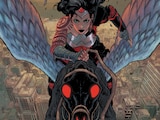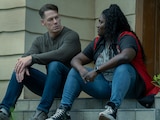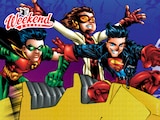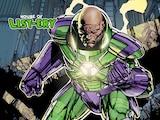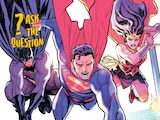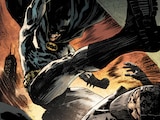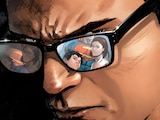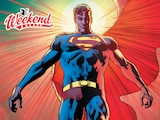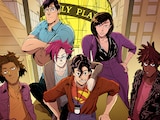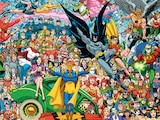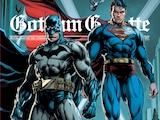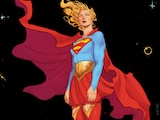Making your way in the world today takes everything you got. Taking a break from all your troubles sure would help a lot. Wouldn’t you like to get away? Sometimes, you want to go… where everybody is an extremely dangerous and deeply stupid killer-for-hire in the heart of Gotham City.
As we celebrate DC in the '90s, it’s worth recalling that this is the service that Hitman provides. Excessively violent, frequently raunchy and stupidly funny, Hitman is the story of what would happen if your average street level hoodlum in Gotham ended up with superpowers. It’s a book that cuts through the crap with a heat vision focus, asking questions up front like “Why was everybody so cool about Superman’s stupid mullet?” “What happens to regular guys during a planetary crisis?” And, most importantly to its first volume, “Why doesn’t anybody just…kill the Joker?”

Hitman Vol. 1: A Rage in Arkham is a perfect example of mirthful fun-poking at the skewed logic of the DC Universe and the superhero genre itself. It’s not a mistake that the book’s protagonist, Tommy Monaghan, never once calls himself “Hitman.” You’ll soon realize that’s the point.
Tommy makes his disastrous first impression (in the best way) by crashing through two different series before landing headfirst in his own ongoing title. So, to keep your bead on the Hitman, you’ll want to follow him through these introductory issues:

The Premise:
Hitman is arguably…okay, looking at the other guys who came out of this, in-arguably the most successful spinoff from DC’s 1993 “Bloodlines” event. A snapshot example of ’90s violent excess, “Bloodlines” was a story running through DC’s 1993 Annuals about a race of alien parasites who come to Earth to drink our spinal fluid. Usually, the consequence of this is painful death, but on rare occasions it awakens the metahuman gene in the victim.
Such is the case with Tommy Monaghan, a Gulf War veteran and low-level hitman for hire based in Gotham’s multi-ethnic neighborhood nicknamed “the Cauldron.” For his trouble, Monaghan walks away from the attack with x-ray vision, telepathy and a side-effect of both his eyes turning solid black—which he hides under a stylish pair of shades. Tommy decides that with minor superpowers comes minor lucrative advantages and he employs these abilities in field work and irresponsible bar bets down at his favorite drinking hole, Noonan’s.
A sixty-issue story of friendship among the world’s roughest rejects, the horrors of war that linger long after its end and a general policy to take absolutely nothing seriously follows from there. And it all begins with Monaghan’s first job after gaining his superpowers: a contract to kill the Clown Prince of Crime. It should be easy money, right? By all accounts, the Joker’s locked up tight in Arkham, defenseless but for the asylum’s own security. All you have to do is get to his cell and pop him in the head. How hard could that be?
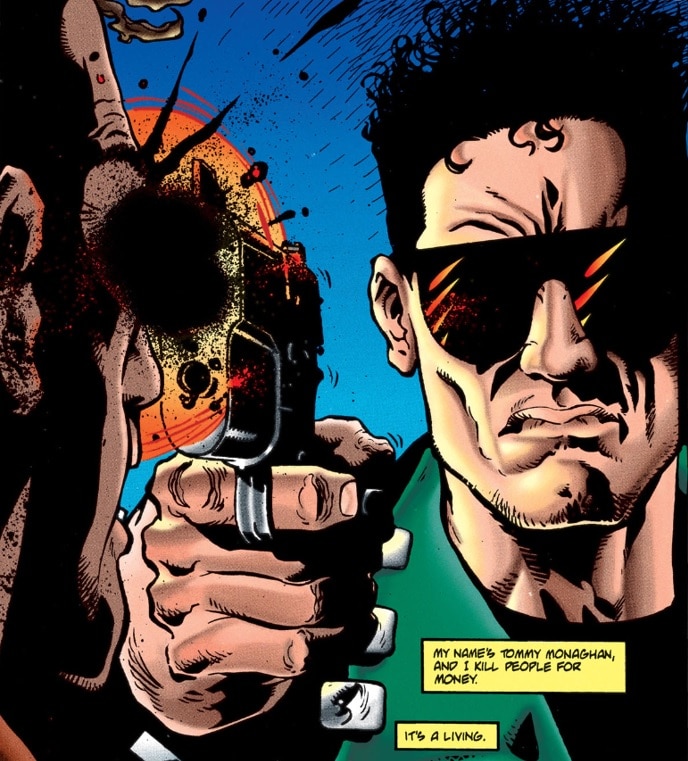
Let’s Talk Talent:
The irreverent tone of Hitman starts to make sense once you recognize the author: superhero comics’ most celebrated critic and parodist, Garth Ennis. You may know him as the man behind The Boys, a similarly cynical take on the fascist undertones of a superpowered super-class with no accountability. Hitman exists somewhere in the thematic overlap between The Boys and Ennis’ other comic opus, The Darkness, an edgy demon-heavy series which did everything it could to live up to its name in the ’90s. It’s no wonder that Hitman originally spun off from The Demon, Ennis’s prior work in collaboration with artist John McCrea.
McCrea follows Ennis to Hitman and continues doing what he does best—drawing mangled guts and horrifying demons, who continue to plague Tommy throughout the series. You’ll meet one of Monaghan’s most persistent hellborn antagonists, the gun demon Mawzir, right in this very first story arc as the Joker mission goes predictably but delightfully FUBAR. The result is one of DC’s rare works of true long-running collaboration between writer and artist, as Ennis and McCrea continue their nasty work together over the entire run of Hitman. Truly a testament to what can be done when two depraved minds come together.

A Few Reasons to Read:
- A Hell of a Time: For those of you interested in the occult side of the DC Universe, Ennis is always a name to follow. In addition to his other bona fides, Ennis is well known to Hellblazer fans for having one of the most well-regarded runs on John Constantine. And as Hitman itself spins off from Ennis and McCrea’s The Demon, you can expect plenty of Hell throughout Monaghan’s misadventures for a closer look at the Bad Place.
- Friends in Low Places: When Tommy isn’t literally or figuratively going to Hell, much of Hitman’s action is set at Noonan’s Sleazy Bar, where you’ll get to know some of the most detestable friends you’ll ever make. Tommy’s drinking buddies are about as violent and deranged as lowlife killers come, but you’ll come to recognize the heart in each and every one of them. There’s a reason that “Noonan’s” is a favorite drinking spot on the Harley Quinn animated series and slated to get its own spinoff to boot—it’s the place where super-villains can be Super Friends.

- Who’s Afraid of the Big Bad Bat?: “Criminals are a superstitious and cowardly lot,” Batman declared one night as he began his war on crime. But if anyone’s ever existed to test that theory, it’s Tommy Monaghan. In A Rage in Arkham’s second chapter, Monaghan, the exact kind of criminal scum Batman pictured in his mind’s eye before the word “super-villain” ever crossed his mind, meets Batman for the first time. It’s an encounter which sets the tone for the rest of Hitman’s tenure in the Cauldron, refusing to buy into the mythology that the super-set create around each other and reminding us just how silly comics can be when you look at them with some perspective.
- The Old Ultra-Violence: Hitman is never afraid to emphasize the ridiculousness of genre tropes, but it never does so without indulging in a few of its own—namely, the egregious, bloody wanton violence which comics in the ’90s so often celebrated. You’re not going to make it through an issue of Hitman without getting a little bit of blood and guts on you. And if that’s the kind of thing that turns you on, then Hitman is where you belong.

Why It’s Worth Your Time:
If you haven’t read Hitman, then trust me when I say it’s unlike anything DC had published before. You never could have published Hitman before the ’90s, and you probably couldn’t get away with it now. It is a story defiantly of its time, and a perfect snapshot of what it was like to write to an audience feeling a little skeptical of the idealism traditional heroes represent (a concept which, conversely, Hitman would eventually reckon with in its award-winning 34th issue, where Monaghan has an unforgettable rooftop meeting with Superman). Tommy Monaghan is nobody’s hero, but he’s the kind of dirtbag you’d love to get a beer with in some back alley bar that would never pass a health inspection. To paraphrase an aphorism scrawled in filthy bathrooms everywhere: for a good, sleazy time, call Hitman.
Hitman Vol. 1: A Rage in Arkham by Garth Ennis and John McCrea is available as a collected edition trade paperback and can be read on DC UNIVERSE INFINITE.
Alex Jaffe is the author of our monthly "Ask...the Question" column and writes about TV, movies, comics and superhero history for DC.com. Follow him on Twitter at @AlexJaffe and find him in the DC Community as HubCityQuestion.
NOTE: The views and opinions expressed in this column are solely those of Alex Jaffe and do not necessarily reflect those of DC Entertainment or Warner Bros.

